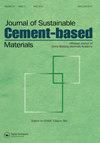水泥基材料与聚乙二醇/海泡石复合相变材料:水化、机械和热性能
IF 4.2
3区 工程技术
Q1 CONSTRUCTION & BUILDING TECHNOLOGY
Journal of Sustainable Cement-Based Materials
Pub Date : 2023-10-30
DOI:10.1080/21650373.2023.2269391
引用次数: 0
摘要
摘要采用真空浸渍法制备了聚乙二醇(PEG)/盐酸改性海泡石(HSEP)复合相变材料(PCMs)。HSEP具有较高的吸附能力,优于天然海泡石作为PEG载体。由此制备的复合pcm具有高达88.9 J/g的熔化焓,在室温至65℃的100次加热-冷却循环中保持稳定的热性能和化学结构,因此表明长期可靠性。对含有30%复合PCMs的水泥浆体的量热研究表明,3天累积水化热降低了24.14%。然而,水泥浆体的机械强度和导热性受到不利影响。因此,引入碳纤维(CFs)作为增强材料,使得含有20%复合PCMs和0.6% CFs的水泥浆体的28天抗压强度达到45.6 MPa。所制备的复合相变材料在混凝土结构水化控热和蓄能方面具有广阔的应用前景。关键词:海泡石形态稳定复合材料聚甲基丙烯酸甲酯基材料水化热热储能披露声明作者未报告潜在利益冲突。作者获得了国家自然科学基金国家杰出青年科学基金项目(51925903)。国家自然科学基金面上项目(52108196)。高性能土木工程材料国家重点实验室(2020CEM001);中国铁路科技研究项目(2020YY240610, K2020G033)。本文章由计算机程序翻译,如有差异,请以英文原文为准。
Cement-based materials incorporated with polyethylene glycol/sepiolite composite phase change materials: hydration, mechanical, and thermal properties
AbstractIn this study, a series of polyethylene glycol (PEG)/hydrochloric acid-modified sepiolite (HSEP) composite phase change materials (PCMs) are fabricated via vacuum impregnation. HSEP exhibits high adsorption capacity, rendering it superior to natural sepiolite as carriers for PEG. The resulting composite PCMs possess a melting enthalpy of up to 88.9 J/g and maintain stable thermal performances and chemical structures over 100 heating–cooling cycles between room temperature and 65 °C, thus, indicating long-term reliability. Calorimetry studies on cement paste containing 30% composite PCMs reveal a 24.14% reduction in 3-day cumulative hydration heat. However, the mechanical strength and thermal conductivity of the cement paste are adversely affected. Hence, carbon fibers (CFs) are introduced as reinforcement, resulting in a 28-day compressive strength of 45.6 MPa for cement paste containing 20% composite PCMs and 0.6% CFs. The fabricated composite PCMs are promising functional materials for hydration heat control and energy storage in concrete structures.Keywords: Sepioliteform-stable composite PCMscement-based materialshydration heatthermal energy storage Disclosure statementNo potential conflict of interest was reported by the authors.Additional informationFundingThe authors greatly acknowledge the National Outstanding Youth Science Fund Project of the National Natural Science Foundation of China (51925903). General Program of National Natural Science Foundation of China (52108196). State Key Laboratory of High Performance Civil Engineering Materials (2020CEM001). Science and Technology Research Project of China Railway (2020YY240610, K2020G033).
求助全文
通过发布文献求助,成功后即可免费获取论文全文。
去求助
来源期刊
CiteScore
6.60
自引率
15.90%
发文量
71
期刊介绍:
The Journal of Sustainable Cement-Based Materials aims to publish theoretical and applied researches on materials, products and structures that incorporate cement. The journal is a forum for discussion of research on manufacture, hydration and performance of cement-based materials; novel experimental techniques; the latest analytical and modelling methods; the examination and the diagnosis of real cement and concrete structures; and the potential for improved cement-based materials. The journal welcomes original research papers, major reviews, rapid communications and selected conference papers. The Journal of Sustainable Cement-Based Materials covers a wide range of topics within its subject category, including but are not limited to: • raw materials and manufacture of cement • mixing, rheology and hydration • admixtures • structural characteristics and performance of cement-based materials • characterisation techniques and modeling • use of fibre in cement based-materials • degradation and repair of cement-based materials • novel testing techniques and applications • waste management

 求助内容:
求助内容: 应助结果提醒方式:
应助结果提醒方式:


